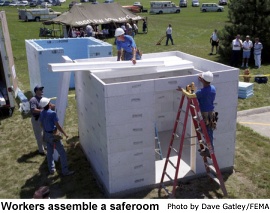The
freight-train-like sounds and dark funnel clouds of
a tornado are among the most frightening weather phenomena
known. Tornadoes can occur in any state at any time, but they are most common in the Midwest and
Southeast during March and April. They form with little
warning and strike with a vengeance. Long-term preparedness
is the only defense residents have.
any time, but they are most common in the Midwest and
Southeast during March and April. They form with little
warning and strike with a vengeance. Long-term preparedness
is the only defense residents have.
Just
ask Beth Bartlett of Del City, Oklahoma. Last spring,
a "safe room" built in her home saved her life, as well
as her motherís and the lives of their four pets. Their
neighborhood was completely destroyed, and a neighbor
was killed, during a tornado that struck there. But,
they survived thanks, in part, to work the Federal Emergency
Management Agency (FEMA) is doing.
Project
Impact
Through
"Project Impact: Building Disaster Resistant Communities,"
FEMA is reinventing the way America handles disasters.
The strategy is to help communities help themselves
before a disaster strikes.
The
initiative is about getting businesses and other organizations
to work together to head off the potential ravages of
a natural disaster, including minimizing a disasterís
effects on residents, businesses, and community infrastructure.
Forging
a Change
Project
Impact began in December 1997 with seven communities
participating in the pilot program. Its purpose: to
encourage communities to form public/private partnerships
to limit potential damage before disasters strike instead
of spending millions to pick up the pieces after the
fact. Today, more than 120 communities nationwide are
participating in Project Impact.
One
city where Project Impact is making a difference is
Oakland, California, one of the original seven pilot
communities. The city established "Project SAFE," a
community partnership for "safety and future empowerment."
The partnership includes local businesses, citizens,
grassroots organizations, the City of Oakland government,
the California Office of Emergency Services, and FEMA.
 In
the spring of 1998, dozens of student volunteers got
Project SAFE rolling by retrofitting over 150 homes
in Oakland through a community project called "Project
Impact Spring Break." Next, during Project SAFEís "Week
of Caring," four volunteer teams of firefighters, AmeriCorps
members, and others spread across the city each day
to make homes of elderly and low-income residents more
disaster-resistant. The teams installed smoke detectors
and cupboard latches, strapped water heaters and freestanding
cabinets to house frames, and rigged safety releases
on window security bars.
In
the spring of 1998, dozens of student volunteers got
Project SAFE rolling by retrofitting over 150 homes
in Oakland through a community project called "Project
Impact Spring Break." Next, during Project SAFEís "Week
of Caring," four volunteer teams of firefighters, AmeriCorps
members, and others spread across the city each day
to make homes of elderly and low-income residents more
disaster-resistant. The teams installed smoke detectors
and cupboard latches, strapped water heaters and freestanding
cabinets to house frames, and rigged safety releases
on window security bars.
Safe Rooms Save Lives
One
of the most valuable actions citizens can take to minimize
damage from a tornado is to build "Tornado Safe Rooms."
The safe room that saved Beth Bartlett and  her
family is a cast-in-place concrete room that normally
serves as a roomy closet. Safe rooms can cost as little as $2,000, and can be built above ground or below, within a home or
attached to one. But, when constructed according to
FEMA specifications, all can withstand winds of up to
250 miles per hour and the impact of objects traveling
at 100 miles an hour.
her
family is a cast-in-place concrete room that normally
serves as a roomy closet. Safe rooms can cost as little as $2,000, and can be built above ground or below, within a home or
attached to one. But, when constructed according to
FEMA specifications, all can withstand winds of up to
250 miles per hour and the impact of objects traveling
at 100 miles an hour.
Help
is Just a Click Away
The
safe room project is part of FEMAís Project Impact.
Residents of tornado-prone areas can now get construction
plans directly from the Internet by accessing FEMAís
Internet site. Once on the site, click on "mitigation,"
then click on Tornado Safe Rooms. (Comprehensive information
about Project Impact is available on the FEMA Internet site
as well.)
The
construction plans include a 25-page illustrated publication,
"Taking Shelter from the Storm: Building a Safe Room
Inside Your House," that outlines the basics of in-house
safe room shelters, including designs for several different
kinds of safe rooms, materials, and construction cost
estimates. (You also can order the publication and construction
plans free of charge by calling FEMA Publications
at [888] 565-3896.)
Clearly,
Project Impact and safe rooms are common sense approaches
for dealing with disasters before they happen. A disaster-resistant
community is able to bounce back from a natural disaster
with far less loss of property and much less cost for
repairs. And, the investment is well worth the cost.
FEMA estimates that for every dollar spent in damage
prevention, two dollars are saved in repairs.
For
more information about FEMA and Project Impact, during
regular business hours, contact FEMAís Public
Affairs Office at (202) 646-4600. Round-the-Clock information
about FEMA and Project Impact also can be obtained by
calling FEMA Fax-on-Demand at (202) 646-FEMA or the
FEMA Radio Network at (800) 323-5248.
10/6/99
Home |
Privacy |
Contents |
Comments |
Email Me |
Search